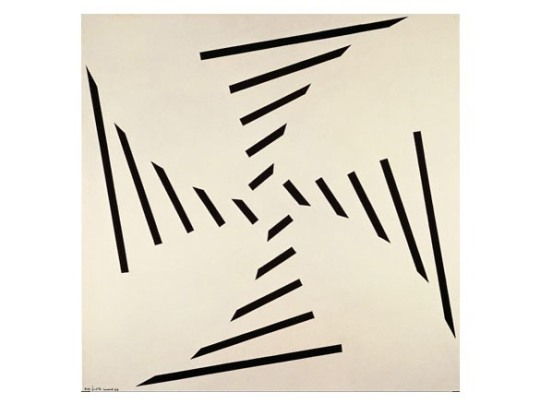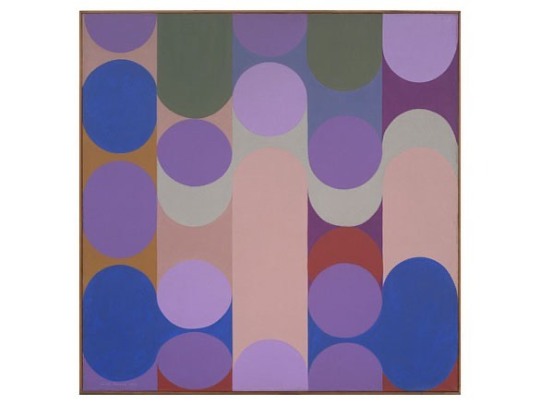#ladyofconcreteart
Photo

Judith Lauand The tumultuous historical and artistic events that marked the art scene in Brazil during the 1950s can be understood through the work of a particular artist: Judith Lauand. The artist was born in Pontal, São Paulo, in 1922. Lauand produced over one hundred works between 1950 and 1959, a crucial period in the development in her artistic career. Paintings, drawings, gouaches, tapestries, woodcuts, woodcut woodblock and sketches on several types of paper, photographs, notebooks, catalogs and other material that constituted a body of work which not only showed her Concretist production but also her artistic process and the stylistic transformations that her work underwent through that decade. Lauand’s prolific artistic journey took her through academic painting, figurative expressionism, lyrical abstraction, and, finally, concrete art, in which she established her artistic identity. But despite being framed by concrete art, her work is unique for the subtle and feminine manner with which she approaches the rational, mathematical, and formal rigour of her compositions. #neonurchin #neonurchinblog #dedicatedtothethingswelove #suzyurchin #ollyurchin #art #music #photography #fashion #film #words #pictures #neon #urchin #escoladebelasartes #sãopaulo #paintings #drawings #gouaches #tapestries #woodcuts #gruporuptura #concreteart #ladyofconcreteart #judithlauand (at Brazil) https://www.instagram.com/p/CQseYoalHlH/?utm_medium=tumblr
#neonurchin#neonurchinblog#dedicatedtothethingswelove#suzyurchin#ollyurchin#art#music#photography#fashion#film#words#pictures#neon#urchin#escoladebelasartes#sãopaulo#paintings#drawings#gouaches#tapestries#woodcuts#gruporuptura#concreteart#ladyofconcreteart#judithlauand
4 notes
·
View notes
Photo

Judith Lauand Brazilian painter Judith Lauand (b. May 26, 1922) proclaimed that her work was “based on elements that are inherent to painting itself: form, space, colour and movement. I love synthesis, precision, and exact thinking.” She was the only woman in ‘Grupo Ruptura’ a São Paulo-based coterie of Concrete artists, who emphasised rationality and mathematical rigour in their work. Like many ‘Grupo Ruptura’ members, Lauand leaned heavily on Gestalt theory’s explanation of the mechanics of vision - to create paintings suggestive of movement and three-dimensionality. In this work, black lines painted around a central void appear to rotate like a vortex, while the unframed board seems to float off the wall. ‘Concrete 61’, 1957. #neonurchin #neonurchinblog #dedicatedtothethingswelove #suzyurchin #ollyurchin #art #music #photography #fashion #film #words #pictures #neon #urchin #escoladebelasartes #sãopaulo #paintings #drawings #gouaches #tapestries #woodcuts #gruporuptura #concreteart #ladyofconcreteart #judithlauand (at Brazil) https://www.instagram.com/p/CQsedj2F7Al/?utm_medium=tumblr
#neonurchin#neonurchinblog#dedicatedtothethingswelove#suzyurchin#ollyurchin#art#music#photography#fashion#film#words#pictures#neon#urchin#escoladebelasartes#sãopaulo#paintings#drawings#gouaches#tapestries#woodcuts#gruporuptura#concreteart#ladyofconcreteart#judithlauand
0 notes
Photo

Judith Lauand In 1950, Judith Lauand completed a degree in ‘Fine Arts' at the former ‘Escola de Belas Artes’ in Araraquara (state of São Paulo) and began her artistic career. During the period that immediately followed, her life and work began to undergo major transformations. Lauand left Araracuara with her family - of Lebanese origin - and moved to São Paulo. There she met, interacted with, and was influenced by artists like Waldemar Cordeiro, Luiz Sacilotto, Geraldo de Barros, Hércules Barsotti, Lothar Charoux and Willys de Castro, among others. Lauand witnessed the birth of the ‘São Paulo Art Biennial’ founded in 1951 - and participated in it - first as an advisor (1953) and then as an artist (1955). In 1952 she showed her work for the first time at the ‘Museu de Arte Moderna’ in São Paulo in the exhibition ‘Young Painters of the Escola de Belas Artes’ in Araracuara. In 1954, the year that marked the fourth centennial of the city of São Paulo, Lauand presented her first solo exhibition at the ‘Galeria Ambiente’ and was invited to integrate the ‘Grupo Ruptura’ the group responsible for the introduction (in 1952) of concrete art in Brazil. The exhibition was titled ‘Rupture at the Museu de Arte Moderna' in São Paulo. Lauand was the only woman in the group, thus the epithet “Lady of Concrete Art” was given to her. Interestingly, in a short period of ten years, Lauand managed to stand out in an art world completely dominated by men. She did so by entirely devoting herself to her artistic production as if it were the only way forward. At a time when young women would only leave their homes accompanied by their husbands Lauand’s artistic trajectory was also defined by her daring attitude. She broke her engagement to fully pursue her true vocation: art. She loved the simplicity of concrete art and brought to that language subtlety that was very much her own. #neonurchin #neonurchinblog #dedicatedtothethingswelove #suzyurchin #ollyurchin #art #music #photography #fashion #film #words #pictures #neon #urchin #escoladebelasartes #sãopaulo #paintings #drawings #gouaches #tapestries #woodcuts #gruporuptura #concreteart #ladyofconcreteart #judithlauand (at Brazil) https://www.instagram.com/p/CQseQRgl5aD/?utm_medium=tumblr
#neonurchin#neonurchinblog#dedicatedtothethingswelove#suzyurchin#ollyurchin#art#music#photography#fashion#film#words#pictures#neon#urchin#escoladebelasartes#sãopaulo#paintings#drawings#gouaches#tapestries#woodcuts#gruporuptura#concreteart#ladyofconcreteart#judithlauand
1 note
·
View note